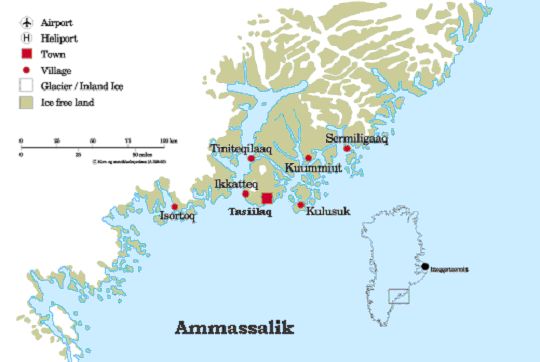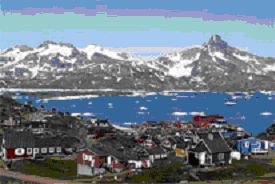
Eastgreenland:
Municipality of Ammassalik and Kulusuk
Basic information
Amount of inhabitants on the east coast of Greenland is about 4000. Coastline itself is about 3500 km long.According to the census of year 2001 the municipality of Ammassalik had total of 2.899 citizens,with 1.728 living in the town Tasiilaq and 1.171 living in the 7 settlements Kuummiut, Kulusuk, Tineteqilaaq, Sermiligaaq, Isertoq, Ikatteq and Qernertuarsuit. The rest of the population of east coast lives in the municipality of Ittoqqortormiut. Ice-free land taken into account the municipality is the largest in Greenland and covers an area of 243.000 km2, or 5 times the size of Denmark.

Transport connections
There are several weekly flights to the community, in part via Nuuk and Kangerlussuaq from west coast of Greenland and partly via Kulusuk airport from Keflavik/Reykjavik in Iceland. The amount of flights can change greatly according to weather conditions. The sailing season runs from the beginning of July to the end of October. Otherwise the sea is frozen or covered of drift and/or pack ice.Outside the sailing season there are weekly helicopter flights to all settlements, except Ikatteq and Quernertuarsuit.
Economy
The local rate of taxation has been fixed at 27 % in 1998, and tax revenues of app. 34 million DKK are expected. The total cost of operations and fixed assets in 1997 is expected to be 144 million DKK against equivalent revenues.App. 700 employees receive wages from the local authorities and converted into full-time employment the number is app. 240Only about a 100 years has passed since the first Europeans arrived in Ammassalik, so traditional Inuit culture still has an important role to play in everyday life. But Eastgreenland is also a modern community with all the facilities found elsewhere in the world.
Kulusuk
Total inhabitation of Kulusuk village is about 350. Weekly
flights from domestic airport of Reykjavík and several weekly
flights via helicopter to Tasiilaq. Tasiilaq can also be reached by
a ferry during summer from july to october. Native culture is well preserved;
daily hunting trips to hunt polar foxes and seals exist as also preparation
of seal skins, drum dancing, manufacturing of tupilaqs and other small
scale production of other handcrafted items. Polar bears can be seen
during the spring but during other times of the year visits of polar
bears are very unusual.
Modern comforts include high quality hotel (Hotel Kulusuk) and general
store (Pilersuisoq) featuring variety of consumer products. All major
international debit/credit cards ar accepted for cash withdrawls or
payments. Various outdoor activities include dog sledding, hiking, and
skiing during winter and kayaking or mountain climbing during summer.Local
spoken language is east-greenlandic but west-greenlandic and danish
are tought in school. School has one Danish and one Greenlandic teacher
as educated teachers and the amount of pupils is about 40.
Village included also a church and Kulusuk Trading Post that sells souvenirs
and numerous handcrafted items. Souvenirs and especially tupilaqs are
also often sold by the local people themselves. Immaqa is a very important
local word. It means maybe or perhaps. Everything in Greenland depends
on weather, ice or other nature conditions. This means that it is impossible
to guarantee 100% certain adventures or activities and also transport
can be difficult or impossible.

Inuits or eskimos?
Sometimes it is argued whether to call local people as inuits or eskimos. Of these two the word inuit is much more polite and commonly accepted by inuits themselves. It means "the people" when the word eskimo was invented by East-Canadian indians and means "eaters of raw meat". Similar mocking word exists also in Icelandic that is desribed in the sagas, skrælingar, which means "small devils".

Tupilak
Originally tupilak was a shamanistic tool in a way the
woodoo is in Haiti. Tupilaks were made of different materials of the
nature, animal, bird and human remains and sometimes there was even
parts taken from child´s corpse. Tupilak was assembled in hidden
and isolated place where the magic was than casted over them. After
the rituals done by the witch, either man or woman, the tupilak was
ready to use as a tool to kill an enemy. But if the enemy had stronger
skills of wizarddry than the attacker, his power could reverse the tupilaks
might and course. Therefore use of tupilaks was very unreliable and
dangerous for both, the attacker and the target.
As the curious and ignorant Europeans started visiting Greenland, inuits
carved tupilak figures to show how the creatures looked like. Naturally
all the original tupilaks were vanished, because they were made out
of disintegrating materials. Figure of tupilak is known in all inuit
regions around the world. however the traditions of making these figures
have changed during the times. The oldest known tupilaks were made of
wood and skin belts and it is said that they bared the greatest reseblance
to original ones. Soon the figures were tried to make as terrifying
as possible to make it easier to sell these objects to foreign visitors.
In the 1950´s until the 1970´s the tupilaks were made in
more or less stereotypical form, althought nowadays the artists create
figures of great artistic craftsmanship. And due to whale conservation,
the tupilaks are these days made mostly from reindeer bone - but some
of them are made also from narwhal tusk or even polar bear bone.
The skills for tupilak making are still alive in East-Greenland and
they have become a trademark of the east coast of Greenland. It is therefore
also hard to mention any specific artist that makes tupilaks, althought
the name of Gedion Qeqe in Tasiilaq is well known producer of tupilaks
and mythical creatures of great artistic and technical quality of reindeer
horn and narwhal tusk. Reindeer bone is often imported from West-Greenland,
but for example narwhal, seal and polar bear bones can be acquired locally
in East Greenland area. Contemporary tupilaks are not anymore dangerous.
The only risk is that the person collecting them might become fascinated
about Greenlandic mythology or to become addicted in collecting them
with particular interest.
